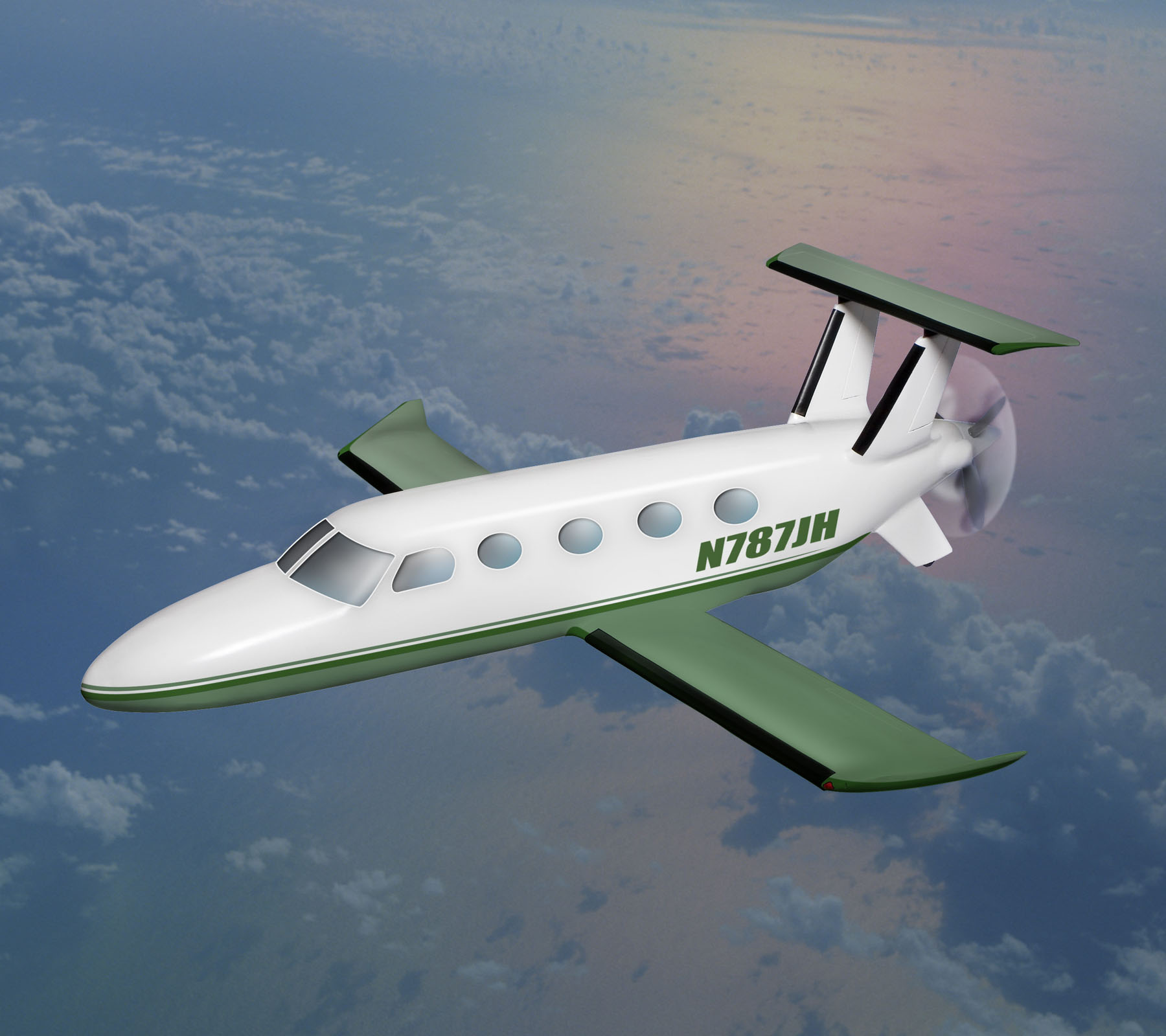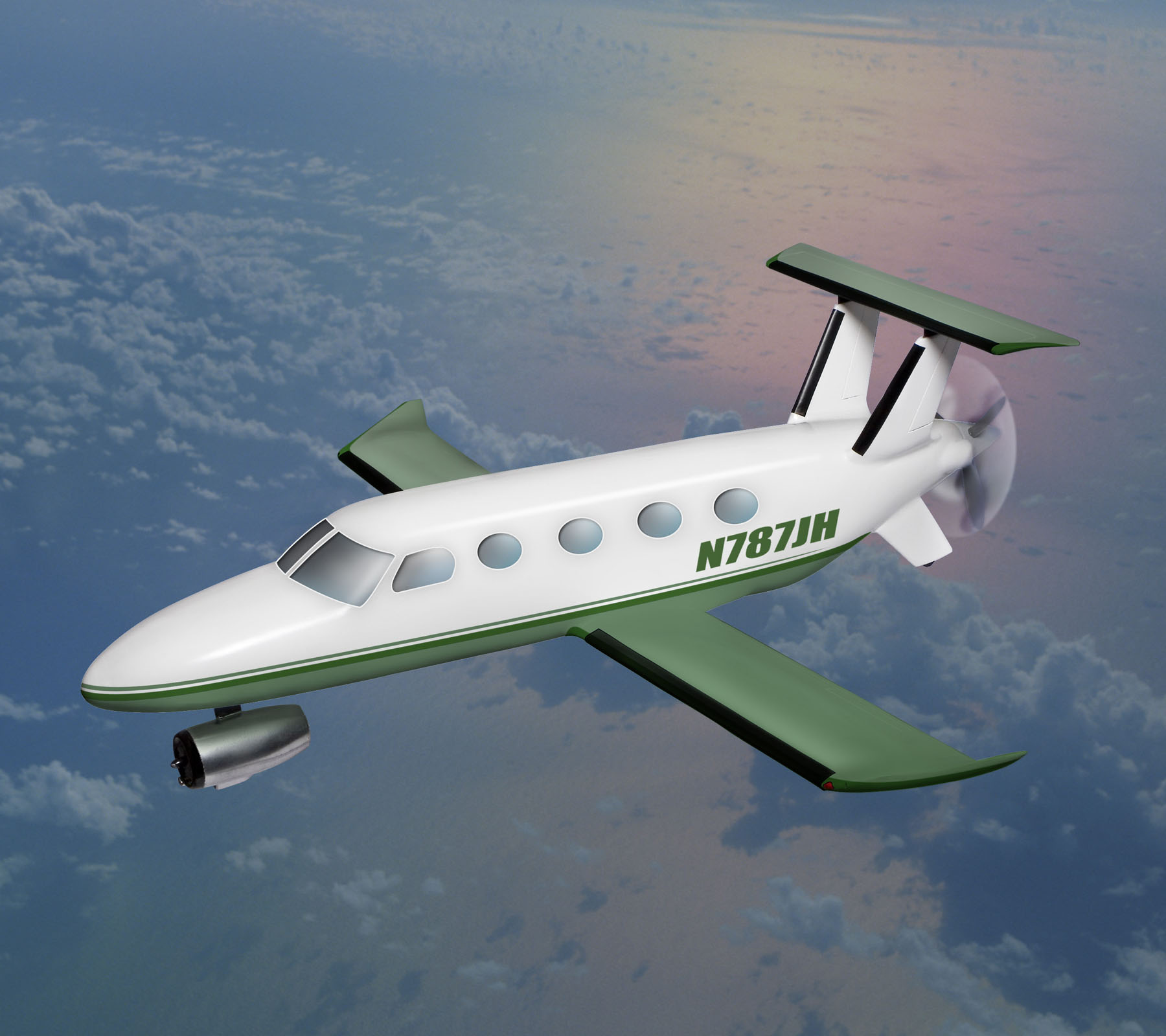
Summary
A New Innovative
Fuel
Efficient Airplane
Hutterer
Engineering, Wichita, Kansas,
has designed a new 10 seat airplane which has the engineering
designation AD-9. The
primary advantage of this aircraft is a 40% reduction in fuel
consumption, which is obtained by installing a rear
engine/propeller and a front-mounted auxiliary fan jet engine to
obtain a “clean” airframe design.
There are other important advantages relating to safety,
passenger comfort and operational flexibility. The aircraft design
is oriented to the commercial market, although it will also appeal
to private and government operators.
The cabin is large relative to the passenger capacity, with
space available for a private lavatory.
The large cabin door is designed to facilitate air cargo
operations.
The AD-9
airplane has a single turboprop (turbine engine with a propeller)
mounted at the rear in a “pusher” configuration.
The aircraft will therefore look somewhat like a business jet
and will also have a quiet cabin. The most innovative feature of
this aircraft is the incorporation of a small fan jet engine,
mounted in the nose section, ahead of the cabin.
Both Pratt-Whitney and Williams International have recently
developed small fan jet engines suitable for this application.
When the fan jet engine is not operating, it is inside the
nose section (retracted position).
When it is to be used for takeoff and climb, or in the event
of loss of power from the turboprop engine, it is deployed downward
to its operational (extended) position, outside of the fuselage
contour. When the fan
jet is no longer needed, it is retracted to within the nose section
and the covering door is then closed, leaving an aerodynamically
clean surface. This
configuration eliminates the need for wing-mounted engines, which
cause additional weight, drag and fuel consumption.

The AD-9 “gross weight” is about 2/3 that of a conventional
twin. The net result is
that the aircraft has the efficiency of a single-engine airplane
with the back-up power and safety of a twin-engine airplane.
The pilot also has the option to use the fan jet, along with
the main turboprop engine, to increase cruise speed.
An efficiency analysis of a number of turboprop aircraft,
expressed as “Passenger Miles per Gallon” (pm/g), demonstrates that
at a 500 mile range, the AD-9, operating on the main turboprop
engine, gets 55 pm/g compared to an average of 30 pm/g for 4 popular
conventional twin turboprops.
This comparison is the basis for the claim that the AD-9
airplane is 40% more fuel efficient than a conventional turboprop
twin.
A business plan
has been developed to build a flying “non-conforming” flight test
airplane incorporating AD-9 concepts at a relatively low-cost.
“Non-conforming” means that the prototype, while not
identical to the AD-9 airplane, will have similar dimensions and
will be suitable for developing engineering data, demonstrating the
auxiliary jet engine concept, and for obtaining initial market
response. This low-cost
vehicle will be created by modifying an existing Cessna 400 series
airframe. This aircraft
will be built in a small facility in
Wichita, Kansas, requiring 18 months for construction
and 6 months for flight test and initial marketing.
The designer of
this aircraft, Joseph A. Hutterer, has 42+ years of technical and
marketing experience in the General Aviation industry.
His associates in Wichita have similar
levels of experience in
Wichita
based General Aviation manufacturing companies.
A United
States
utility patent, #7,549,604, covering the basic design concept has
been issued. The concept
can be scaled up to aircraft larger than the 10 seat airplane
proposed. The business
plan suggests several post-prototype business options regarding
additional investment, production and marketing.
------ ------- ------- -------
The Online Think Tank is impressed with this innovative design,
and looks forward to the full development of this new
ultra-efficient aircraft. The future of aviation looks bright, and
it's great to see the best and brightest in the United States
continue to push the envelope on efficiency, safety, and design.
Hutterer Engineering is doing just that. This AD-9 Concept Aircraft
solves many problems in General Aviation today. Congratulations Joe
Hutterer - Excellent Work!